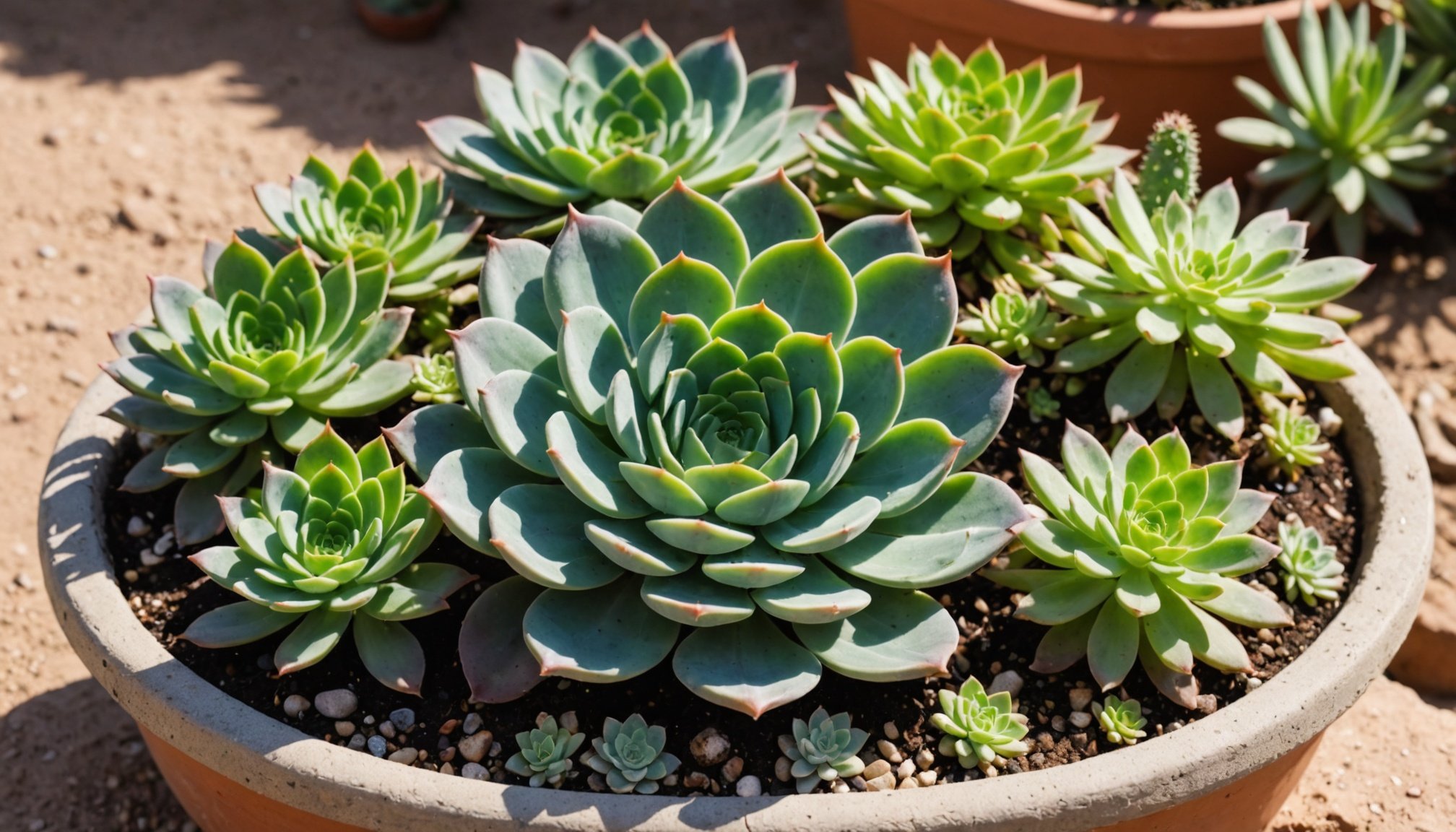Understanding Succulents and Their Benefits
Succulents are unique, low-maintenance plants prized for their water-retaining leaves and stems, making them ideal for dry climate gardening. These plants feature thick, fleshy tissues that store water, enabling them to thrive in arid environments where other plants may struggle. This trait makes succulents an excellent choice for those looking to reduce water usage while maintaining a vibrant garden.
Benefits of Succulents in Arid Environments
Succulents offer numerous benefits, particularly in dry climates. Their drought tolerance means they require minimal watering, conserving resources while supporting eco-friendly gardening practices. Additionally, succulents assist in soil erosion control due to their extensive root systems, which stabilize the ground.
Also to discover : Paws and Passages: Crafting Modern Homes with Smooth Indoor-Outdoor Access for Pets
Popular Succulent Varieties for Dry Climates
There are several succulent varieties that thrive in arid regions, each bringing its own charm to your garden. Some popular choices include:
- Aloe Vera: Known for its medicinal properties and attractive foliage.
- Echeveria: Offers beautiful rosette shapes and an array of colours.
- Agave: Features dramatic, architectural leaves.
Incorporating these succulents into your garden not only enhances its aesthetic appeal but also provides practical benefits. Explore these robust plants to create a thriving sanctuary in even the driest conditions.
Also to see : The complete handbook for selecting energy-efficient appliances in your tiny home kitchen
Selecting the Right Succulents
Choosing succulents can be an enjoyable task if you consider specific factors that enhance their resilience in dry climates. A pivotal consideration is the plant’s drought tolerance, which determines how well it can thrive with minimal watering. Opt for succulent types known for their adaptability, such as those with thick leaves or rosettes.
When selecting, assess the local climate conditions. Some drought-tolerant plants may perform better in environments with extreme temperature fluctuations, while others might prefer milder conditions. Light exposure is another critical factor, as some succulents, like certain succulent species, require full sun, whereas others may flourish in partial shade.
Another aspect involves identifying companion plants that can coexist healthily with succulents. When integrated wisely, companion plants complement succulents by maintaining soil quality and offering pest control. Choose varieties such as ornamental grasses, which lend both functionality and beauty to your garden.
By considering these elements, you ensure your dry climate gardening ambitions remain both sustainable and visually appealing. Exploring diverse succulent species not only enriches your garden’s aesthetic but also contributes to biodiversity, making your outdoor space a vibrant sanctuary.
Ideal Soil for Succulents
Succulent soil plays a crucial role in ensuring the health and longevity of your plants. Using the correct soil types for succulents is vital because it directly influences water retention and root health. Well-draining soil is essential as succulents are prone to root rot in overly moist conditions. A mix of potting soil, coarse sand, and perlite or pumice often serves as the ideal base, allowing for efficient drainage while providing some moisture retention.
When creating a homemade succulent potting mix, opt for:
- 1 part potting soil: Provides the necessary nutrients.
- 1 part coarse sand: Enhances drainage.
- 1 part perlite or pumice: Increases aeration and prevents compaction.
The right balance ensures your succulents have the structure they need without excessive moisture.
It’s important to test the mix by watering and checking how quickly it drains. Over time, regularly assessing and adjusting the mix will cater to your specific succulents’ needs. Consider planting in containers with drainage holes to further prevent water accumulation. Understanding and implementing the proper soil drainage techniques will support thriving, beautiful succulents.
Effective Watering Techniques
Providing proper watering for succulents is paramount for their thriving. Understanding the best practices ensures their longevity, especially in dry climates. The ‘soak and dry’ method is widely recommended, allowing the soil to dry out completely before giving it a thorough drench. This technique mimics their natural habitat conditions, helping prevent root rot.
Monitoring is essential to avoid overwatering or underwatering. Drooping leaves can indicate too much water, while shriveling may suggest a need for hydration. Observing your succulents regularly assists in fine-tuning their care process.
Adapting your watering routine with seasonal changes is crucial. For instance, during the growing season in spring and summer, succulents typically need more frequent watering. Conversely, in the dormant winter months, reduce watering to prevent excess moisture in the soil.
Effective watering requires attention to succulent care, tailored for different environmental conditions. Remember, every succulent species might react differently, so it is wise to start with smaller amounts of water and adjust according to their response. Mastering these watering methods will ensure your succulents remain vibrant and healthy.
Maintenance and Care for Succulents
Keeping your succulents healthy involves a few key maintenance tasks. Regular attention ensures these resilient plants thrive and reach peak beauty. Among the most crucial care practices is pruning succulents. Trimming supports airflow and prevents pests. You can remove dead leaves or overgrown sections to maintain their shape and promote new growth.
Repotting is also essential, usually necessary every 1-2 years. Repotting helps refresh the soil and give the roots more room if the succulent seems constrained. Always choose slightly larger pots with proper drainage.
Another aspect of succulent maintenance is monitoring for common pests, such as mealybugs or spider mites. These can be controlled using natural pesticides or by wiping affected areas with a mild insecticidal soap.
Diseases like root rot often stem from overwatering. To avoid such pitfalls, ensure your succulents are in well-draining soil and follow recommended watering guidelines. If you notice any wilting or discoloration, investigate causes promptly.
By adhering to these maintenance tips, your succulents will remain robust and attractive. Remember, consistent care goes a long way in keeping plants happy. Engaging with succulent communities can further enhance your knowledge and success in growing these fascinating plants.
Designing Your Succulent Sanctuary
Crafting a succulent garden design allows you to create an inviting and visually pleasing space tailored to your preferences. Incorporating creative ideas ensures your garden not only thrives but also becomes a personal sanctuary filled with aesthetic allure.
Arranging succulents for maximal visual impact involves considering their varying heights, colours, and textures. You can layer taller species at the back of a display, with medium and small-sized varieties closer to the foreground, creating a dynamic composition. Utilize symmetry or asymmetry based on your stylistic preference to enhance the overall garden arrangement.
To amplify the aesthetics of succulents, consider integrating decorative elements like stones, gravel, or driftwood. These embellishments complement the natural beauty of succulents, providing contrast and texture while aiding in water retention.
Furthermore, using containers of different shapes, sizes, and materials can add an interesting element to your sanctuary. Options range from ceramic and terra cotta to recycled materials, giving your succulent garden a unique flair.
Through thoughtful design choices, you can elevate your outdoor or indoor space, transforming it into a picturesque haven. Embrace experimentation with arrangements and accessories, paving the way for a tranquil and inspiring environment.
Common Pitfalls and How to Avoid Them
In the world of succulent care, even seasoned gardeners encounter common pitfalls that can affect plant health. Understanding these gardening mistakes is crucial for maintaining vibrant plants.
One typical challenge is overwatering. Succulents require specific moisture levels, and excess water can lead to root rot. Always ensure proper soil drainage and use the ‘soak and dry’ method to mimic natural conditions. Conversely, underwatering can cause leaves to shrivel, so monitor your succulents regularly.
Light exposure is another area where mistakes occur. While most succulents appreciate sunlight, introducing them too abruptly can lead to sunburn. Gradually acclimate plants to brighter environments.
Pest issues, such as mealybugs, are also common. Regularly inspect your succulents and opt for natural pest control measures when needed.
Troubleshooting involves careful observation and swift action. For example, if you notice discolouration or wilting, assess whether pests, diseases, or environmental factors are to blame, then adjust care practices accordingly.
Stay informed by joining gardening communities and learning from fellow enthusiasts. Education and continual resources are essential for honing your skills, allowing you to shoulder challenges with confidence.
Resources for Further Exploration
Engaging with gardening resources is crucial for succulent enthusiasts eager to deepen their knowledge and hone their skills. There are various succulent care guides available in books and online platforms that offer comprehensive information, ranging from basic care to advanced gardening techniques. These resources provide valuable insights into selecting the best practices for maintaining succulent health and beauty.
For those looking to connect with fellow enthusiasts, online communities and forums are rich grounds for exchanging tips, discussing challenges, and discovering new succulent varieties. Forums like Reddit’s r/succulents or dedicated Facebook groups host vibrant discussions, offering support and inspiration.
Additionally, attending local gardening clubs or workshops can enrich your succulent knowledge. These gatherings often provide hands-on experiences, aiding in understanding specific care requirements unique to local climates. Workshops frequently cover topics like repotting techniques and pest management, offering practical skills for optimising succulent care.
By exploring these diverse resources, gardeners can stay informed and enthusiastic, continually enhancing their succulent collection. Whether through reading, online interaction, or local events, the opportunities for learning are vast and rewarding, fostering a thriving gardening experience.

